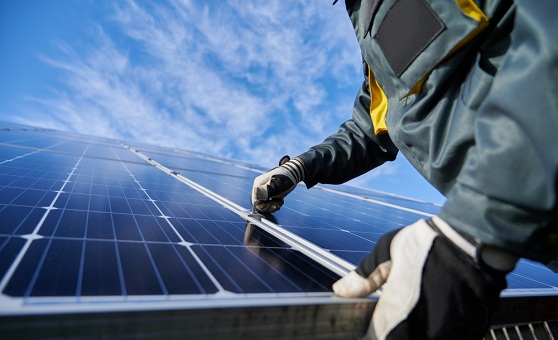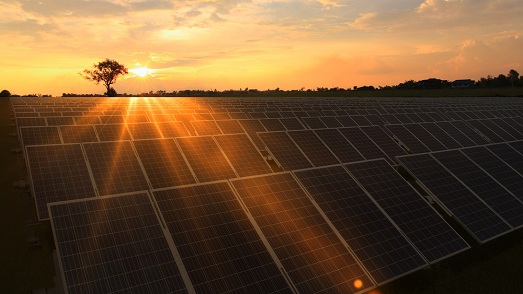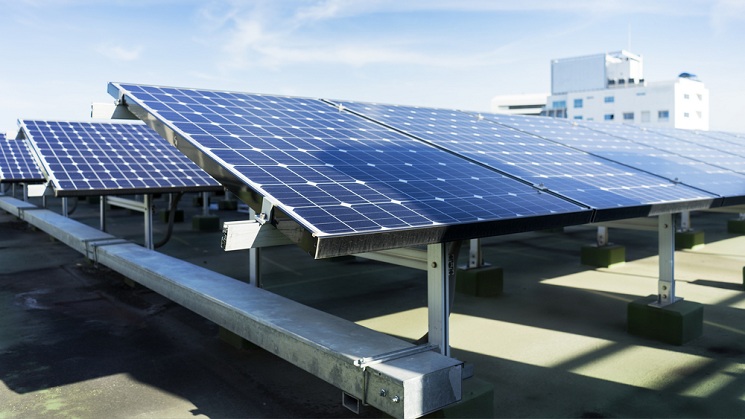Most people don't realize how hot solar panels can get, nor how much they lose power efficiency in hotter climates due to increased thermal losses.
The truth is, when temperatures reach over 90°F, the performance of solar panels can drop significantly -especially for older solar panels.
What is Solar Panel Efficiency?
The relative ability of a solar cell to convert 1 Joule of sunlight energy into 1 Joule of electrical energy is called the solar panel's efficiency rating.
The definition of solar panel efficiency is as follows:
Solar Panel Efficiency = (Maximum current x Maximum voltage)/Power from absorbed light.
A 100% efficient solar panel would convert all the sunlight it receives into electrical power without losing a bit of it. This is not realistic, of course.
Solar panels can usually convert 15% to 22% of solar energy into usable energy. So a loss of 5% due to heat can significantly affect how much usable power you'll get.
Solar panel manufacturers list the efficiency of their products in product descriptions and on their specification sheets.
But these numbers can be misleading due to the way solar panels are tested.
Standard Test Conditions for Solar Panels
Standard test conditions for measuring the performance of solar panels aren't exactly realistic. But they do provide insight into how well solar panels perform under real-world conditions.
Solar panel efficiency is determined by testing them under Standard Test Conditions (STCs).
STC specifies a light intensity of 1000 W/m2 at 25 degrees Celsius.
This is the equivalent of a sunny day when the incident sunlight hits a 37°-tilted mirror.
For these test conditions, a 15% solar cell efficiency with a 1 m2 (10 ft2) surface area would generate 150 watts.
Apart from the standard testing conditions, solar panel manufacturers perform extensive tests under extreme conditions.
So, what is the optimal solar panel temp?
According to the National Renewable Energy Laboratory (NREL), the average temperature of the air around solar panels during daylight hours is about 75 degrees Fahrenheit.
This is why the best-operating temperatures for solar panels are between 50 and 85 degrees Fahrenheit.
How Temperature Impacts Efficiency

But what happens when your panels heat up?
Like any other electrical equipment, the efficiency of solar panels increases as they become cooler and less efficient when they get hot.
Solar panels are designed to absorb sunlight, converting it into energy. This process heats the boards, causing them to release heat into the surrounding environment. So when you look at a solar panel outside, it seems like they are putting out a lot of excess heat.
Why Do Solar Panels Heat Up So Much?
Solar panels are much warmer than the ambient outside temperature due to their dark color, an intentional design choice for a sunlight absorber.
As solar cells become heated by sunlight, the operating temperature increases well beyond ambient air temperature.
For example, the average temperature in the desert is 113 degrees Fahrenheit, and solar panels there can exceed 150 degrees Fahrenheit. The panels and racks that hold them are not designed to be touched on a hot day, either.
Temperature Coefficient (TC): Impact Of Temperature On Efficiency
As with any other electronic device, the efficiency of solar energy decreases when the system gets too warm.
How do you know how much energy your solar cells produce at a given temperature?
To figure out how much electricity your solar panels might generate at different temperatures, look up the temperature coefficient (TC) on the manufacturer's data sheet for your solar panels.
These numbers tell you, in percentages per degree Fahrenheit, how much power your solar panels will lose for each degree over 77°F / 25°C.
For example, a solar cell with a TC of -0.5% would lose 5% units of energy for every 10 degrees C rise in temperature. That means if your solar cell were exposed to a sunny sky during the hottest part of the year, it could experience a drop in performance of 10% or more.
The temperature coefficient of an LG NeON 2 solar cell is -0.24 percent per one degree Celsius, which means that for each degree Celsius above 25°C, the maximum output of an LG NeON2 solar cell reduces by 0.24 percent - and for each degree Celsius below 25°C, the maximum power output increases by 0.24 percent. (yes, cooler days are better for your solar cells)
So if the temperature outside is 100 degrees Fahrenheit (37 Celsius), the efficiency of a typical LG NeON® 2 PV module would be reduced by about 3%.
Does Shade Affect Solar Panel Efficiency?

Shade reduces the amount of light reaching the solar cells, naturally reducing the amount of electricity produced by solar panels.
However, this doesn't mean solar panels don't work in the shade. They still generate some electricity.
In addition, the shade will cool the panels, increasing their efficiency slightly. Not nearly enough to overcome the lack of direct sunlight, however.
You can hire a solar contractor who can assess your property to determine its solar capacity and the number of solar energy systems that should be designed for maximum efficiency.
They will consider all shading factors when creating your home plan to get the most out of your investment.
The Pmax Temperature Coefficient (TC) found on the solar panel's datasheet indicates how per degree change on either side affects efficiency.
To find out how much power you will lose to heat in the summertime, multiply the Pmax by the difference between the actual temperature of the solar panels and the standard test temperature (25C / 77F).
Typical losses during the hottest part of the summer will range from 2% to 6%.
This means an older 18% efficiency solar panel could lose up to 1/3 of its power-generating capability, but a highly efficient modern set of panels may only lose 12%.
4 Tips to Keep Your Solar Panels Cool & Efficient
Keeping solar panels cool isn't rocket science.
But you can do a few things to keep your solar panels running efficiently, as follows:
1) Elevate your panels off the ground to allow proper airflow around the boards and away from the sun. This helps prevent overheating.
2) Buy Polycrystalline panels. Poly solar panels tend to run cooler than monocrystalline panels because they're less reflective. In addition, black mono panels absorb more light energy, causing them to heat faster.
3) Install a temperature gauge near your panels. It can help determine whether they're operating too hot or cold. You can then adjust power consumption as needed.
4) When installing a new solar array, leave enough space between panels to avoid overheating. Also, keep in mind that the sun moves throughout the sky as the seasons change, so your panels won't receive the same amount of sunlight year-round.


